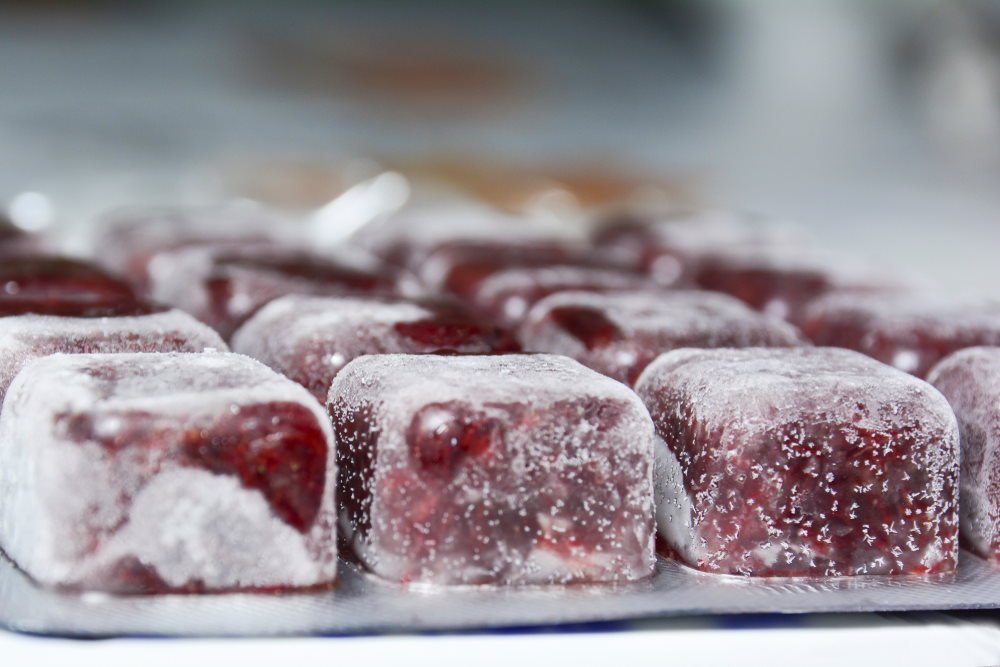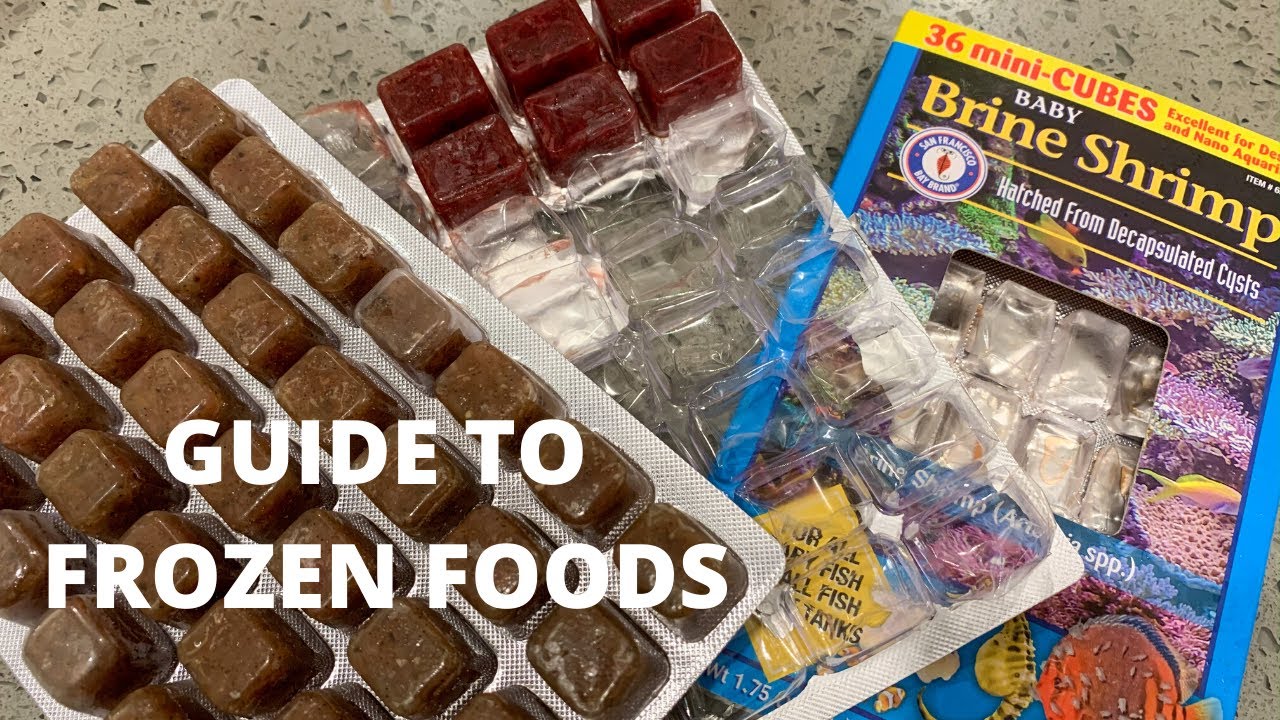Defrost frozen fish food cubes by placing them in a small amount of tank water. Wait a few minutes until the cubes dissolve then feed your fish slowly.
Proper nutrition is vital for the health and vitality of aquarium fish and frozen fish food offers a nutrient-rich diet that mimics their natural feeding habits. These pre-portioned cubes are designed to provide a convenient feeding solution while minimizing waste.
Frozen foods are high in protein and essential nutrients and can cater to the dietary needs of freshwater and marine species. Enthusiasts and aquarists appreciate the ease of using frozen food cubes as they help maintain water quality by reducing leftover debris. With variety as the spice of life, these frozen delights can include brine shrimp, bloodworms, and specialized blends for different fish species, ensuring a well-rounded diet for your aquatic pets. Remember to adjust the amount based on the size and number of fish in your aquarium to promote a healthy ecosystem.

Credit: www.aquariumcoop.com
Frozen Fish Food Cubes: Preparation
Feeding your aquatic friends the right way is essential for their health. The preparation stage of frozen fish food ensures your fish get the full nutrient benefits. Let’s dive into how to get frozen food cubes tank-ready!
Thawing The Frozen Fish Food Properly
Thawing fish food cubes is easy. Do it like this:
- Take out the number of cubes you need.
- Put them into a small cup.
- Add some tank water to the cup.
- Wait 10-15 minutes for the cubes to thaw.
- Check to see if they are fully thawed.
- Drain excess water before serving.
Cutting The Cubes Into Smaller Portions If Needed
Sometimes, you need smaller food portions for your fish. Here’s what to do:
- Use a clean knife or scissors.
- Cut the cube on a cutting board.
- Make sure the pieces are small enough for your fish to eat.
Note: Only cut what you’ll use in one feeding to keep it fresh.
Table of Contents
Frozen Fish Food Cubes Feeding Process
Getting frozen fish food cubes into your aquarium may sound chilly business, but warm up to these steps, and you’ll see finned friends flourish. Follow these clear instructions to bring on a feeding frenzy while keeping your hands nice and dry.
Choosing The Right Feeding Spot In The Tank
Location is everything when feeding fish with frozen cubes.
- Identify areas with less water flow to prevent food from scattering before fish can eat.
- Choose spots away from filters or pumps.
- Opt for accessible regions to observe and ensure all fish get their share.
Dropping the cube in the right place means each swimmer gets a bite of the chilly treat.
Monitoring Fish Response And Adjusting Feeding Amounts
Keep a close watch on your aquatic pals during mealtime. Their reactions will tell you if you’re doing it right or need some tweaks.
- Monitor how quickly they eat the offered food.
- Please adjust the number of cubes according to their appetite.
- Spot uneaten pieces? Decrease the amount next time.
- Are fish still hungry? Consider increasing the cubes.
| Fish Size | Amount to Feed | Observation Period |
|---|---|---|
| Small | Half cube | 5 minutes |
| Medium | One cube | 5-10 minutes |
| Large | One and a half cubes | 10 minutes |
The table helps calibrate the right portion. Offer just enough to keep them healthy and hearty.
Frozen Fish Food Cubes: Tips For Success
Successful feeding of frozen fish food cubes to your aquatic pets ensures their health and happiness. Frozen fish food is nutritious, easy to store, and can mimic fish’s diet in the wild. Let’s explore some tips for making mealtime in your aquarium a splash!
Rotate Different Types Of Frozen Fish Food
Feeding the same food daily can lead to nutritional gaps. Rotating food types is critical. Include a mix of brine shrimp, bloodworms, and veggie blends to provide a balanced diet. It meets various dietary needs and keeps fish interested in their meals.
- Variety stimulates appetite
- Boosts overall health
- Prevents picky eating habits
Avoid Overfeeding To Maintain Water Quality
Overfeeding fish is a common mistake. It harms your fish and disrupts the tank’s ecosystem—leftover food decays, leading to poor water quality and potential health issues. Feed only the frozen food cubes your fish can consume in a few minutes.
Feeding Frequency Quantity
Daily Feedings
One small cube per 4-6 fish
Occasional Treats
Half a cube for smaller tanks
- Watch fish during feeding
- Remove uneaten food after 5 minutes
- Adjust portions if necessary
Remember, a clean tank is vital for fish health. Feed wisely and keep the water pristine.
Dealing With Leftovers
Feeding your fish frozen food cubes is easy and nutritious. However, be mindful of leftovers in the tank. Leftovers can harm your fish’s home. Keeping the tank clean ensures happy, healthy fish. Let’s explore how to manage uneaten food.
Removing Uneaten Food Promptly
Take out leftovers right away to prevent water contamination. Decomposing food spoils the water, putting fish health at risk. Use a net or a siphon for removal. Check hidden spots where food might get stuck. Regular cleaning maintains a pristine environment for your aquatic friends.
Implementing A Feeding Schedule
Create a consistent feeding schedule to reduce waste. Stick to specific times each day. Observe how much your fish can eat in a few minutes. Adjust the cube amount accordingly. Use the following bullet points to help manage the feeding routine:
- Observe your fish’s eating habits.
- Start with small portions.
- Adjust portion size as needed.
- Feed your fish 1-2 times a day.
A structured routine prevents overfeeding and keeps your tank tidy.
Common Mistakes To Avoid for Feed Frozen Fish Food Cubes
Feeding your aquatic friends requires precision and care. Frozen fish food cubes are famous for their convenience and nutrition. Yet, some mistakes can lead to poor nutrition and water quality. Let’s dive into the common errors to sidestep for the health of your fish.
Not Thawing The Food Properly
Thawing feed frozen fish food cubes is essential for easy digestion. Failing to do so can cause health issues. Never rush this process. Allow the cubes to thaw completely at room temperature or in a cup of tank water. Avoid using warm or hot water, as it can destroy vital nutrients.
Feeding Too Much At Once
Overfeeding leads to waste and polluted water. Always measure the right amount. Observe your fish’s eating habits to decide the correct portion size. Start with small quantities. Watch how quickly they consume the food and adjust accordingly.
Follow these tips to avoid common feeding errors:
- Use a dedicated cup for thawing to prevent contamination.
- Rinse the thawed food to remove impurities before feeding.
- Regularly check your fish’s appetite to calibrate feedings.
- Remove uneaten food after feeding to keep the tank clean.

Credit: www.aquariumcoop.com
Compatibility With Fish Species
Feeding the right diet is key to healthy aquarium fish. Frozen fish food cubes are a popular choice. They offer variety and a high nutritional value. Not all fish species will thrive on the same frozen foods, so it’s important to match the food with the fish.
Researching Which Fish Species Benefit From Frozen Food
Different fish have different needs. Research is the first step to understanding these needs. Some fish prefer meaty cubes like brine shrimp or bloodworms. Others might need plant-based options like spirulina. Here’s how to ensure you’re on the right path:
- Start by checking the natural diet of your fish.
- Look for information in fish-keeping books and trusted online resources.
- Use tables to compare fish species and recommended frozen food types.
Additional rows can be added as needed
Fish Species Preferred Frozen Food
Betta Fish
Bloodworms, Daphnia
Cichlids
Brine Shrimp, Krill
Consulting With Experts For Specific Diets
Every fish species may have a unique diet. Consulting with experts can guide you. Look for advice from:
- Aquarium hobbyist groups online or in your community.
- Local fish store experts who can offer personalized advice.
- Veterinarians specializing in aquatic animals.
Remember that diet’s impact is not immediately visible. Changes in fish health can take time. Regular consultation with these experts ensures you stay informed. They can help adjust your fish’s diet as needed.

Credit: m.youtube.com
Frequently Asked Questions
How To Feed Frozen Cubes To Fish?
Thaw feed frozen fish food cubes in aquarium water. Portion out the cubes according to your fish’s size and tank population. Feed directly or disperse in the tank for all fish to access. Avoid overfeeding; remove uneaten food promptly. Adjust quantities to prevent waste and maintain water quality.
Should I Defrost feed Frozen Fish Food cubes?
Yes, you should defrost frozen fish food before feeding it to your fish to ensure easy digestion and prevent aquarium temperature shock.
How Do You Use Frozen Bloodworm Cubes?
Thaw frozen bloodworm cubes before feeding. Please place them in tank water to defrost, then disperse them evenly for your fish to consume. Avoid overfeeding; use only enough that your fish can eat within a few minutes.
What Do You Do With Frozen Fish Food?
Thaw frozen fish food in the refrigerator before use. Offer it directly to your aquarium pets, ensuring proper portion sizes to maintain water quality. Discard any uneaten food promptly to prevent decay.
What Is Frozen Fish Food Cubes?
Frozen fish food cubes are pre-measured portions for aquarium fish, stored at freezing temperatures to maintain freshness and nutritional value.
How To Defrost Frozen Fish Food?
To defrost frozen fish food, place the cube in a cup of water for a few minutes until it thaws.
Are Frozen Food Cubes Safe For All Fish?
Most fish can safely eat frozen food cubes, but ensure the cube is appropriate for your fish’s dietary needs and size.
Can I Feed Fish Frozen Cubes Directly?
Thaw frozen cubes before feeding to prevent digestive issues in fish and maintain aquarium water temperature.
Conclusion
Feeding your fish frozen food cubes doesn’t have to be tough. With the proper technique, it becomes simple and mess-free. Remember to thaw properly, monitor portions, and observe your fish’s health. Embrace this nutritional choice for a happy, thriving aquarium community.
Dive in and watch your aquatic friends flourish!








Leave a Reply